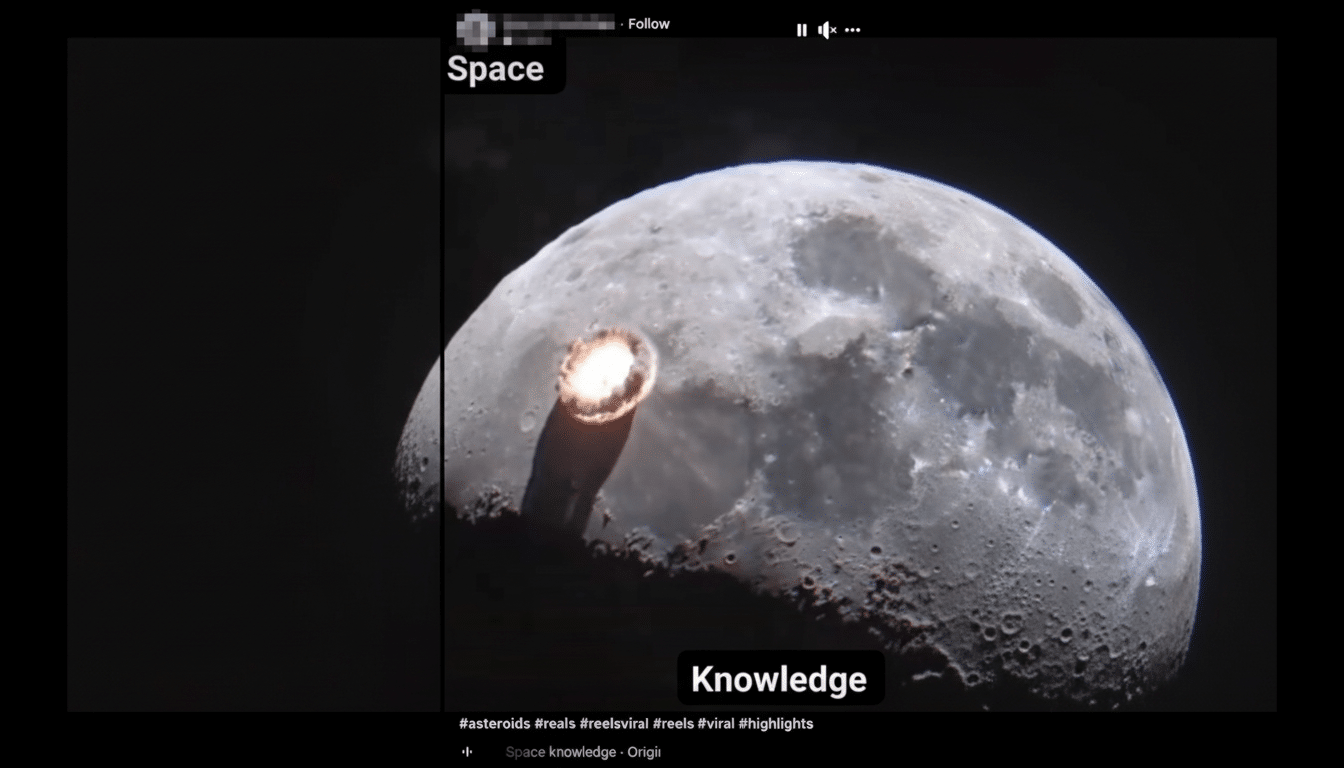A video recently captured by a seasoned night-sky observer in Japan reveals a meteor coming out of nowhere and slamming into the moon at 38,000 miles per hour (61,155 kilometers per hour). The clip, shared by Daichi Fujii, a curator at the Hiratsuka City Museum and recorded above the Oceanus Procellarum region, shows an explosive burst of light that momentarily blazed brighter than anything else on the moon. Amazingly, Fujii captured a second separate flash on a different part of the lunar surface just before that, further proving how dynamic our otherwise tranquil neighbor truly is.
A Split-Second Flash, Yet With Immense Force
These “lunar impact flashes” are only with us for milliseconds or perhaps tenths of a second, but they represent eye-watering energies. Unencumbered by an atmosphere that would slow the progress of falling debris, meteoroids crash onto the moon at speeds typically between 45,000 mph and as much as 160,000 mph. At those speeds, even a rock the size of a bowling ball can dig out a crater several meters wide and toss tens of tons of dust high into the vacuum.

Fujii observes the narrow lunar crescent with several eight-inch telescopes and high-sensitivity video cameras, equipment that is well-suited to capture brief flashes on the dark side of the moon. He estimates that you may see a clear detection only once every few dozen hours of watching, so getting back-to-back captures is exceptional.
Why Scientists Monitor the Moon for Impacts
To scientists who study meteoroids and other small objects throughout the solar system, the moon is a giant detector. The lunar surface is also used as an infinitely large target for quantifying the rate of larger space rocks hitting it, in projects like NASA’s Meteoroid Environment Office and ESA’s NELIOTA programme. Most meteors burn up harmlessly in Earth’s atmosphere; according to NASA, some 48.5 tons of extraterrestrial dust and rubble fall to our planet every day, but the atmosphere dissipates the lion’s share of mayhem-packed energy. The airless moon has no such shield, which means it logs impacts large and small.
How fast and with how much energy those hits come into play. It feeds risk models for satellites, future lunar habitats and surface assets such as rovers and power systems. It also helps to gauge the threat of meteor streams that occasionally intersect the Earth-moon system. Flash brightness, along with estimates of impact angle and velocity, allows researchers to deduce the mass of the impactor and how large a crater it likely blasted — a crucial bit of information for mission planners who are trying to decide where and how to build on the lunar surface.
How Observers Verify a Real Lunar Impact
(Quick flashes of light can also be mimicked by camera artifacts and cosmic rays, so confirmation is key.) Here, separate telescopes in Japan also registered the exact same flashes at various points — a strong suggestion that these were real impacts. That multiple-station approach is common in professional programs, which include the NELIOTA campaign based in Greece and long-term work by NASA’s lunar monitoring team in the United States.

For irrefutable evidence though, scientists often rely on orbital assets. NASA’s Lunar Reconnaissance Orbiter can return to the impact site weeks to months later and look for a fresh scar. Impacts on the lunar surface that were observed from Earth were for example a widely reported flash during a total lunar eclipse, and NELIOTA detections of flashes, which after the analysis completion dates of this work (and thus not included in our results), were linked to newly formed craters: verifying thereby assumptions concerning brightness-to-energy relations used to scale impactor sizes.
A Likely Link to the Taurids Meteor Stream
Such is the timing of these bursts that they match up with annual events like the Northern and Southern Taurids, meteor showers spawned by material dripping off Comet 2P/Encke. The Taurids are known for slow, bright fireballs and the occasional “swarm” years when Earth passes through more crowded filaments of the meteoroid stream. NASA’s Meteoroid Environment Office has traced periodic Taurid flurries to gravitational resonances that trap fragments into dense clouds, increasing the chances of spectacular displays on both Earth and on the moon.
Although it’s difficult to prove exactly where every lunar impactor came from, the flash characteristics and timing of the shower’s active window could be consistent with a Taurid parent. On the moon, those soft-focus Taurid fireballs become high-energy surface strikes — pyrotechnics with no atmosphere to muffle them.
What the Video Shows and How to Watch Similar Events
Fujii’s video captures a pinpoint spark blossoming and contracting before vanishing in a millisecond against the dark mare, a textbook signature of an impact from a meteoroid. The best opportunity to experience such a flash happens when the moon is a thin crescent, with just a small sliver illuminated by sunlight while the majority of its disk is dark. Amateur astronomers use sensitive video cameras that record at high frame rates and look out for sudden spikes — or compare detections between observers — to rule out false positives.
Lunar flashes aren’t exactly common, but they are not all that rare either. And when merged with systematic data from NASA and ESA, records compiled by dedicated observers such as Fujii are starting to provide a real-time catalog of how the solar system remakes the lunar surface today. Each confirmed flash hones our image of the meteoroid environment — and trains explorers and equipment to survive, and thrive, in harshly fluctuating lunar reality.

